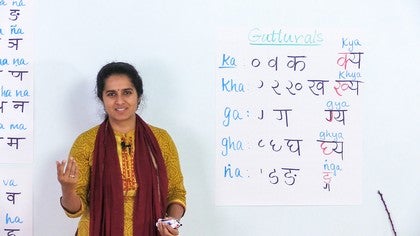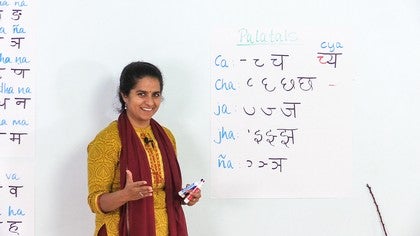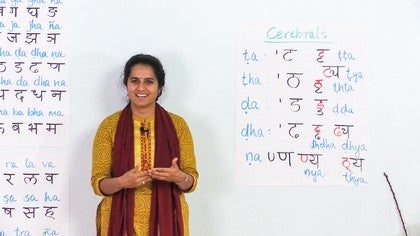Description
About This Video
Transcript
Read Full Transcript
Namaste, Priya Mitrani, my dear friends, we've been having this super adventure with all the different sounds of the Sanskrit alphabet. Lately we saw the vowels, how they were written and then in the next session we saw the vowels, how they were combined with the consonants. So now what we are going to do is pay a little more attention on the consonants as different groups. So we had the five groups of pronunciation, we had the gutturals, the palatas, the cerebrals, the dentals and the labials, the lips. So in each of those places of pronunciations in Sanskrit it's known as sparsha meaning the touch. Where is this touch happening? A note there is that the difference between the vowel and the consonant is that in a consonant there is an element of touch. Whereas a vowel is an open sound, it doesn't need anything else to give it that color. So you have an aah but in a consonant you need that element of touch, aah which gives you the ka, ka and that is what the word vyanjana in Sanskrit actually means. So we have vyanjana in the Devanagari script there. So we have five letters pertaining to every place of touch or sparsha. There's another component that is important in pronouncing the sounds is the element of prayatna. What is the degree of breath or effort you are putting into that sound? So the first one, k is just a simple touch sound, k, also known as the unvoiced consonant. Unvoiced guttural. The second one has an element of breath. You see the edge there? So it becomes the ka which is the component of maha prana. In Sanskrit maha means great. Prana, all of you in the yoga world already know that prana is this breath force. So you add that great breath to that touch. So you have ka, then we have the voiced or the sound touch of the gh and that is also the alpa prana where there is not much of breath that is coming in. Then we have the maha prana or the breath, the great breath that gets added on to it. So we have the gh and then we have the nasal ka, ka, ga, ga. Got that? Now let's see if we can write it out. I will try to teach you how to write it stroke by stroke and then we can put it together see what it gives us. So we have the guttural and we will start with the letter ka. So the letter ka which as we already saw before is a combination of the phoneme k plus the phoneme a which is also the vowel. So we get the ka right? So ka is written like that. Start with the round, round and stick, round stick and you can continue to complete the letter and put the line on top like that. Got that? So first just the round then round stick, round stick and complete. That is the ka. The second sound is the ka. We'll see what that is written like. The transliteration is ka and there is a component of this letter and the one that follows as well. It starts a little differently 1 2 3 4. The line on top holds the letter together and gives it its uniqueness or its individuality. The next one is the letter gh. This is a relatively simple letter to get. So it's like 1 2 with a line on top. There you are. That's the gh. The next one is the gh with the extra breath in it. In the transliterated form wherever you see the edge you know that you have to put in that maha prana or the extra breath. So you have the gh which is an interesting one. It's like a sleeping reverse 3 a little bit. So you start with 1 2 and gh. Yes you're following me. We move on to the last letter in this series of the guttural which is the n. It's the nasal sound. In transliteration remember it has the dot on top of the n. 1 2 3 and we put the line on top to complete it. There. So we have the n. Can we just go that once together quickly? So k round 2 3. In Sanskrit the writing is normally from left to right and the way the letter forms also follows that direction of movement. The k 1 2 3 and then 4. The gh is just a simple one and gh. The gh 1 2 3. That's it. That's the gh and then we have the n which is the 1 2 3 and the dot. Don't forget the dot because if you leave the dot out then it becomes the d. I'll show it to you here. If you leave the dot out then it becomes this letter which is the d. So the dot is very important to indicate that actually it is the nasal guttural sound. What I'd also like to show you is how you can write these letters half. That is only when you have the phoneme and it combines with another consonant. What does it look like? I will put it for you on the side so that it remains as a visual impression and then as you study the language further and learn how to read you can always fall back on this to help yourselves. So the k when it is written half is like that. So if you wanted to combine the k with the let's say with the with the sound year which we have here we would get the year like that here. You see that? So it's half there. So that's how you combine them. You can also see it on this word vyanjana which has quite a few combined consonants. We have the v the half v the phoneme v plus the year plus the near half of that plus the j which is there and then the n and the vowel are. So you see how they look different when they are independent and as we had mentioned in any relationship when you put two things together there is a slight compromise there is a readjustment there is a re-looking of what your original form is. So that is what we observe when we put these consonants together as well. So that is when you have a half here. You might find some other variations as well but I think we'll stick to the simple ones to begin with and as and when we encounter a new word I can point it out to you. The second one is more simple. So we had the curl and if you want to keep adding the year to it you just drop the stick and you add that letter on here and then we move on to the girl. So half of the girl is again very simple it's just I'll do it again just to keep our color code going so that is how it would look and you add the year to that gear. So that's the half girl and the year the stick normally falls off. So now you can guess what will happen to the girl right. So as you would have already guessed you write half that the stick drops and you add the next letter to it year gear. Now what happens to the no is very interesting because it just washes up a little. So it becomes a I will add the consonant girl to that so that you see what happens. So the girl actually comes below it like that. See that entire letter just comes below it. So the letter becomes a little smaller so there we have. So that's the curve half of it is the cure. For your advantage I can also write it in transliteration so that's the cure. The full cure looks like that and you make it into the cure. The third one is the girl half of it becomes the gear. The girl combined with the year gives the gear. The girl combined with the girl gives you. Yes you can also try now to close your eyes and just see if you can retrace these sounds. So cure. I can show it to you but then you just need to remember that you should not mirror me because then you'll get the letter backwards. So let's see if you can do it. I'll just give you a demo of how you can feel the letter as you draw it. I'll just do it with one and you know how to do it with the others. Alright there we go. So cure. Got it. You can also try writing it very small. You know this size difference has a different imprint in your brain when you write it big and then you write it very small. You tune yourself to learning it in different ways. So cure, cure, cure, cure, cure, cure, cure. And before I leave you I would like to just give you also the inner experience or the psychological vibration of these sounds. So the sound cure corresponds to the power of will. The sound cure to the power of will but with greater expression or greater force. The cure is the power of expression. Cure, power of expression with force. And cure corresponds to manual dexterity and articulation. In terms of the body they correspond to different parts but that's another whole story. We can have a look at it together some other time. Thank you. Hope you enjoyed this. In our next series we will go on to the palatals. See you till then. Have a nice time.
Mother Tongue: Writing the Consonants
Comments
You need to be a subscriber to post a comment.
Please Log In or Create an Account to start your free trial.










